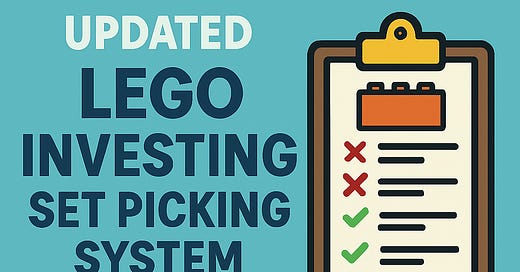TIE #086: A New Update to My LEGO Set Picking System
Allow me to explain how I am now estimating theme supply.
This post is brought to you by me.
By becoming a paid newsletter subscriber here, you get free access to my:
Paid subscriber Discord group (used to cost $329)
LEGO Investing Mastery guide (used to cost $169)
LEGO Investing Hit List (I should charge $1,000 for this)
LEGO Investment Portfolio (Yes, I share it publicly)
LEGO Buy/Sell alerts (I tell you when I buy or sell a set)
Pokémon Booster Box Portfolio
Pokémon Booster Box Buy/Sell alerts
If you want sign up, do so by clicking the button below:
In the latest LEGO hit list update, I mentioned that I had made an update to my set picking system for the first time in over a year.
The prior system worked great, but it had one glaring blind spot:
We kept missing out on sets from underrated themes like NINJAGO, especially from 2023 and now 2024
This is because it only analyzed demand and made a broad assumption that supply for every LEGO set was the same.
Everyone knows this isn’t true, but the ultimate question is how do you confidently estimate it?
At first I didn’t think it was possible. That’s why the system was set up the way it was.
Knowing there must be a way, I spent the last month talking back and forth with AI before settling on what I think does a semi-decent job.
Allow me to explain.
Theory: One can assume that if sets from a given theme underperform vs. the overall average after retirement, it is likely that their supply vs. demand ratio is higher than another theme that does the opposite (all else equal)
Here is an example:
Theme A return on investment 12 months post-retirement: 25%
Theme B return on investment 12 months post-retirement: 75%
Theme A average demand score: 12
Theme B average demand score: 9
(In case you aren’t familiar with it, demand score is my personal rating system that comes from the Amazon sales rank of any given set)
The old set picking system would have favored more sets from Theme A than Theme B in this example because of the higher average demand score.
However, one can assume that Theme B probably had drastically lower supply than Theme A.
I mean, how else would it have reached a return on investment of 75% even though it had less demand?
The most likely answer is that LEGO didn’t make nearly as much of each set in Theme B than they did for Theme A
This is what the updated system now attempts to take into account.



